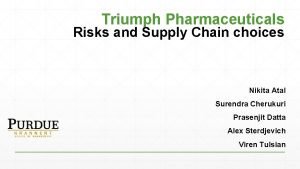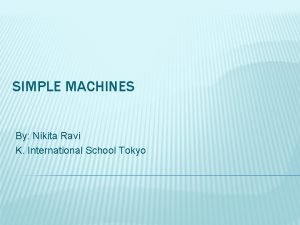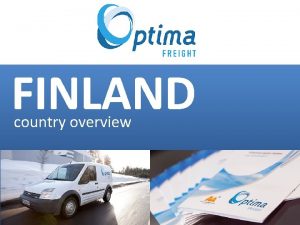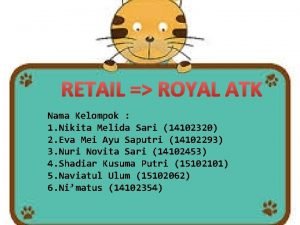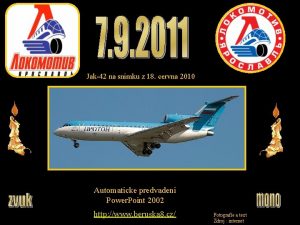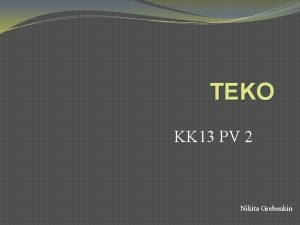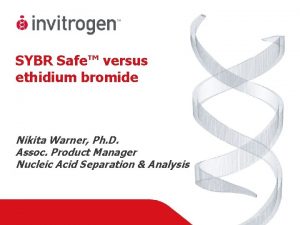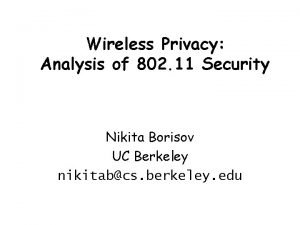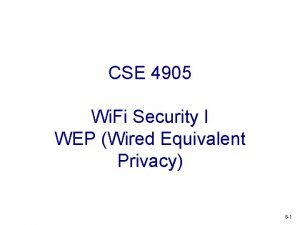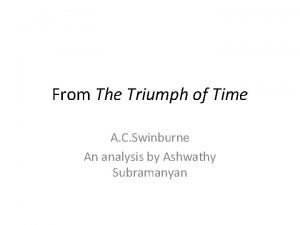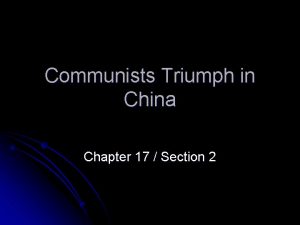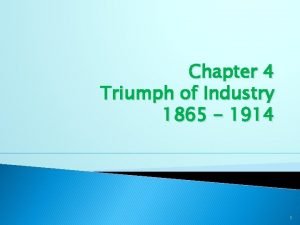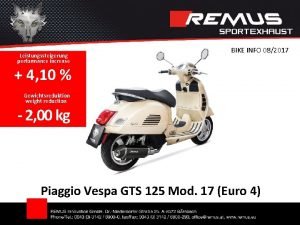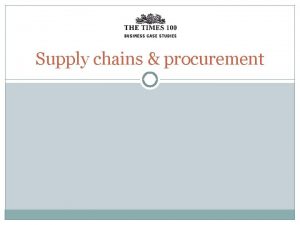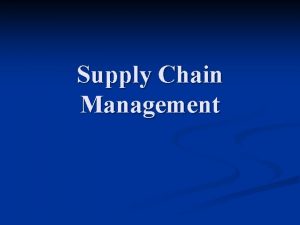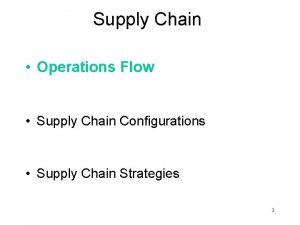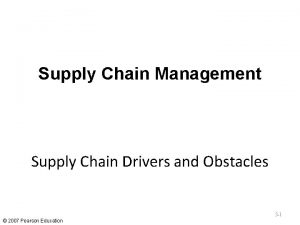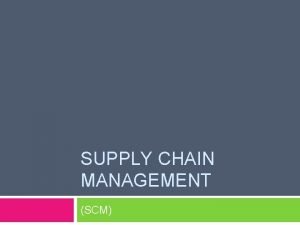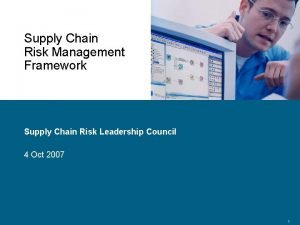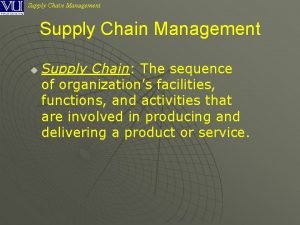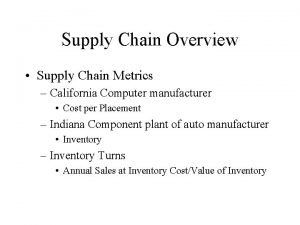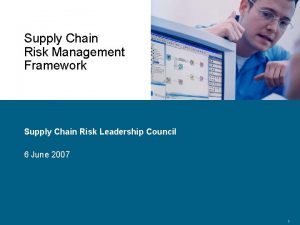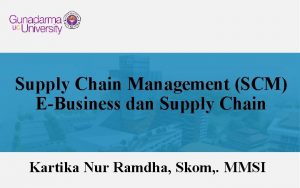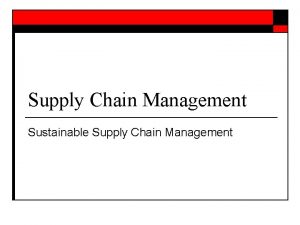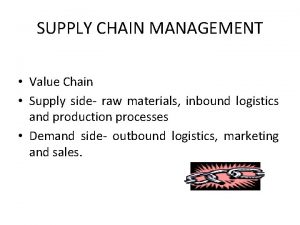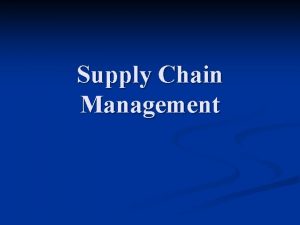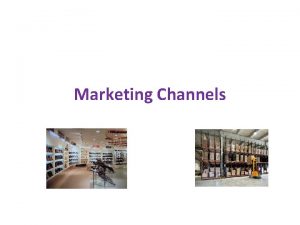Triumph Pharmaceuticals Risks and Supply Chain choices Nikita


























- Slides: 26

Triumph Pharmaceuticals Risks and Supply Chain choices Nikita Atal Surendra Cherukuri Prasenjit Datta Alex Sterdjevich Viren Tulsian

Agenda Current Situation Problem statement Recommendation Analysis Implementation Risks and Mitigation Current Situation Problem Statement Recommendation Analysis Implementation Risks and mitigation 2

Current Situation Manufacturing Process Structure Company considerations ▪ IP leakage considerations ▪ Supply chain disruptions ▪ Supplier’s dependency on the volatility of other industries ▪ Competitive advantagea) sourcing strategy, b) patents and data protection Current Situation Problem Statement Recommendation Analysis Implementation Risks and mitigation 3

Problem Statement Triumph Pharma is challenged with strengthening their Global Supply Chain by developing a sourcing strategy, mitigating risks ofa) Disruption losses b) IP losses Current Situation Problem Statement Recommendation Analysis Implementation Risks and mitigation 4

Recommendations 1 Cost and Risk based sourcing strategy 2 3 Current Situation Accept 10 -year data protection deal Obtain process patent for API-SM and API Intermediate Problem Statement Recommendation Analysis Implementation Risks and mitigation 5

Recommendation 1 Sourcing Strategy Recommended sourcing strategy Expected cost: $5457 / Variance $1404 per kg Current Situation Problem Statement Recommendation Analysis Implementation Risks and mitigation 6

Recommendation 1 Sourcing Strategy • Country analysis Current Situation Problem Statement Recommendation Analysis Implementation Risks and mitigation 7

Recommendation 1 Sourcing Strategy ▪ Using Risk efficient frontier to analyze cost-risk trade-offs for single sourcing vs dual sourcing Dual Sourcing- Vietnam & Peru Stage II Reaction Intermediate Country Base price P(Disruption) Cost Variation Vietnam $ 200. 00 0. 2 $ 208. 00 $ Peru $ 200. 00 0. 4 $ 232. 00 $ 115. 27 C O S T Allocation Risk 83. 45 Efficient Zone- Cost 0% $ 83 $ 208 10% $ 76 $ 210 20% $ 71 $ 213 30% $ 68 $ 215 40% $ 68 $ 218 50% $ 71 $ 220 60% $ 77 $ 222 70% $ 84 $ 225 80% $ 94 $ 227 90% $ 104 $ 230 100% $ 115 $ 232 RISK Assumptions- There is no correlation of disruption risk between two countries Current Situation Problem Statement Recommendation Analysis Implementation Risks and mitigation 8

Recommendation 1 Sourcing Strategy Prioritizing stages for source selection 1. Starting Material for Synthesis (Alpha raw material) - Critical in the supply chain to limit supply shortages 2. API SM & API Intermediate- After source selection both these stages are important to mitigate risk for IP loss 3. Reaction Intermediate- Based on previous decisions, suppliers for this stage can be selected to minimize cost and risk Starting Material Cost Risk Reaction Intermediat e API SM API Intermediate Overall Cost/kg $ 194 $ 215 $ 2, 063 $ 2, 985 $ 5, 457 $ 62 $ 68 $ 1, 052 $ 926 1, 404 $ 95% limit $ 7, 767 Assumptions- No two stages originate in the same country due to an increased risk of IP leakage Current Situation Problem Statement Recommendation Analysis Implementation Risks and mitigation 9

Recommendation 2 and 310 -Year Data Protection and Process Patent Keeping the Patent with process patent In 5 years, Selling Price Assumptions goes down by 50% after generics enter market Data protection deal with process patent In 5 years, Selling Price goes down by 30% after new entrants release their product in market Validity 7 years 10 years Composition IP Loss þ N/A Process Patent Loss þ þ Clinical Trials for Competitors N/A þ Total Revenue from years 6 - 10 $ 87, 499. 90/kg $ 124, 992. 39/kg Assumptions- Profit margin of 80% to estimate revenue Current Situation Problem Statement Recommendation Analysis Implementation Risks and mitigation 10

Implementation Obtain competitive advantage through implementation of sourcing strategy Medium-Term (1 -5 yrs) Short-Term (0 -1 yr) Long-Term (5 -10 yrs) Single sourcing implementation Dual sourcing implementation Develop USA with dual technology model for alpha-raw material stage Develop dual sources to mitigate disruption costs Long-term contracts for USA, Singapore Ramp-up production Local Supplier management capabilities Re-assess market for new entrant Obtain process patent for API-SM and API Intermediate Re-evaluate pricing strategy Develop unique API intermediate-cost reduction project Current Situation Problem Statement Recommendation Analysis Implementation Risks and mitigation 11

Risks and mitigation Risks Probability/ Impact Mitigation Measures Market Risk: Market exposure due to quality inconsistencies/ non-compliance as a result of dual sourcing • Stringent Quality control standards • Develop local supplier management capabilities Demand Risk: Demand inventory fluctuations and challenges due to single sourcing at API-SM stage Enter into a long term exclusive contracts with legal implications for vulnerable suppliers- USA, Singapore Catastrophic Risk: Natural disasters/ political instability Develop a contingency plan for all vulnerable suppliers Analysis low/high Recommendation low/high Problem Statement low/medium Performance Risk: Ongoing supplier quality and financial • Dual sourcing issues • Develop local supplier management capabilities Current Situation medium/high Implementation Risk: Supplier implementation lead time Ramp new suppliers more quickly, ensuring visibility into any risk and production/performance ramp-up factors at an early stage Implementation low/high Risks and mitigation 12

Conclusion 10 -Year Protection Deal Cost and Risk-based Sourcing Strategy Process Patenting Robust Global Supply Chain for Triumph Pharmaceuticals Current Situation Problem Statement Recommendation Analysis Implementation Risks and mitigation 13

THANK YOU!

Appendix- 1 a Cost of Sourcing = Base Price*Price Multiplier*(1+Disruption Probability) Expected Cost and Risk - Using Discrete Probabilities for “No Disruption” and “With Disruption” scenarios to assign expected cost and risk for each country. Sample calculations for Malaysia in Phase-1 - Starting Material: • Expected cost of sourcing= 125*(1 -(0. 2+0. 3))+187. 50*(0. 2+0. 3)= $156. 25 • Risk of sourcing- Is interpreted as the standard deviation= $ 79. 67 Assumptions- The probabilities of disruption risk between different industries are mutually exclusive 15

Appendix- 1 b Stage I Starting Material Country Base price per kg P(Disrupti P(IP loss) on) Price multiplier E(X) (X-μ)^2)*μ SD Malaysia $ 100. 00 1. 25 0. 2 $ 156. 25 $ 6, 347. 66 $ 79. 67 USA $ 120. 00 2 0. 005 $ 249. 60 $ 10, 027. 01 $ 100. 13 16

Appendix-2 a Source Selection and allocation distribution: a, b are allocation percentages, co-variance=0 ▪ Cost for stage▪ Risk for stage- ▪ Using Risk efficient frontier to analyze cost-risk trade-offs for single sourcing vs dual sourcing Allocation 0% 10% 20% 30% 40% 50% 60% 70% 80% 90% 100% Risk 83 76 71 68 68 71 77 84 94 104 115 Cost 208 210 213 215 218 220 222 225 227 230 232 Efficient Zone. For same risk cost incurred is low, the allocation should be in this region Assumptions- There is no correlation of disruption risk between two countries Company Overview Problem Statement Assumptions Recommendation Analysis Conclusion 17

Appendix- 2 b Stage II Reaction Intermediate Country Base price per Price multiplier kg Malaysia $ 200. 00 Vietnam $ P(Disrupti P(IP loss) on) 1. 25 0. 5 200. 00 1 0. 2 Singapore $ 200. 00 1. 5 0. 3 USA $ 200. 00 2 0. 3 Peru $ 1 0. 4 200. 00 E(X) (X-μ)^2)*μ $ 0. 2 $ 312. 50 25, 390. 63 $ 0. 3 $ 208. 00 6, 963. 20 $ 0. 03 $ 327. 00 22, 812. 30 $ 0. 005 $ 436. 00 40, 555. 20 $ 0. 4 $ 232. 00 13, 286. 40 SD $ 159. 34 $ 83. 45 $ 151. 04 $ 201. 38 $ 115. 27 18

Appendix- 3 Stage III API starting material Country Base price per kg P(Disruptio n) Price multiplier P(IP loss) 0. 03 $ E(X) 1, 875 $ (X-μ)^2)*μ 914, 063 SD Singapore $ 1, 200. 00 1. 25 0. 5 $ 956 Malaysia $ 1, 200. 00 1. 25 0. 2 $ 1, 560 $ 391, 680 $ 626 Australia $ 1, 200. 00 1. 75 0. 01 $ 2, 625 $ 1, 791, 563 $ 1, 338 USA $ 1, 200. 00 2 0. 4 0. 005 $ 2, 784 $ 1, 913, 242 $ 1, 383 Mexico $ 1, 200. 00 1 0. 4 $ 1, 212 $ 132, 322 $ 364 19

Appendix- 4 Stage IV API Intermediate Country Australia New Zealand USA Base price per kg $ 2, 000. 00 Price multiplier P(Disruption) 1. 25 1 2 P(IP loss) E(X) (X-μ)^2)*μ SD 0. 2 $ 0. 01 2, 600 $ 1, 088, 000 $ 1, 043 0. 7 $ 0. 01 2, 980 $ 1, 951, 320 $ 1, 397 0. 1 $ 0. 005 4, 040 $ 1, 470, 240 $ 1, 213 20

Appendix – 5 a Alpha raw materials strategy. Allocation 0% 10% 20% 30% 40% 50% 60% 70% 80% 90% 100% Risk 100 90 82 74 68 64 62 63 67 72 80 Cost 250 240 231 222 212 203 194 184 175 166 156 Based on the analysis for Alpha Raw material stage. We require lowest risk for this stage- hence, we chose Malaysia- 60%, USA-40%, for 95% cases, cost will be lower than $ 296 Company Overview Problem Statement Assumptions Recommendation Analysis Conclusion 21

Appendix – 5 b API SM strategy & API Intermediate Strategy ▪ IP loss should be minimized for API SM stage- hence, we eliminate Malaysia and Mexico from consideration as probability of IP loss is 0. 4. Also, we need to incorporate long-term exclusive contracts at this stage- at 20% extra price ▪ Cost is highest for these 2 stages- so cost minimization is important ▪ Out of the other suppliers- USA has already been allocated in stage-1, so we need to choose between Singapore, Australia and New Zealand for these 2 stages Company Overview Problem Statement Assumptions Recommendation Analysis Conclusion 22

Appendix – 5 c API SM strategy & API Intermediate Strategy Analyzing the 3 different combinations- Scenarios Scenario 1 Scenario 2 Source Selection Stage 3 Stage 4 Combined. Stage 3 & Stage 4 Only Singapore Cost $ 2, 228 $ 2, 860 $ 5, 088 Only Australia Singapore & Australia Risk $ 891 $ 1, 147 $ 1, 453 Cost $ 2, 063 $ 3, 278 $ 5, 341 New Zealand Risk $ 1, 052 $ 1, 537 $ 1, 862 Cost $ 2, 063 $ 2, 985 $ 5, 048 Risk $ 1, 052 $ 926 $ 1, 401 Only Singapore Australia & Scenario 3 New Zealand 95% $ 7, 477 $ 8, 403 $ 7, 353 Based on the analysis for API SM strategy & API Intermediate Strategy – API SM strategy- Singapore to be used for sourcing 100%, with long term exclusive contract API Intermediate Strategy – Australia- 70%, New Zealand- 30%, for 95% cases, cost will be lower than $ 6, 684 Company Overview Problem Statement Assumptions Recommendation Analysis Conclusion 23

Appendix – 5 d Reaction Intermediate ▪ Sourcing cost and disruption risk optimization is the primary focus ▪ Out of 5 sources- Only Vietnam and Peru are available as the other countries have been used as a source for the other stages Allocation 0% 10% 20% 30% 40% 50% 60% 70% 80% 90% 100% Risk 83 76 71 68 68 71 77 84 94 104 115 Cost 208 210 213 215 218 220 222 225 227 230 232 Based on the analysis for Reaction Intermediary phase. Optimal Allocation is Vietnam- 70%, Peru-30%, for 95% cases, cost will be lower than $ 327 Company Overview Problem Statement Assumptions Recommendation Analysis Conclusion 24

Appendix – 5 e Sourcing Strategy ▪ Combining all of the decisions from all of the 4 stages Starting Material Reaction Intermediat e API SM API Intermediate Overall Cost 95% limit Cost $ 194 $ 215 $ 1, 875 $ 2, 714 $ Risk $ 62 $ 68 $ 956 $ 842 $ 4, 998 $ 7, 099 per kg 1, 277 25

Appendix-6 Discrete distributions Probability - PATENT= IP loss*Process patent loss - Data Protection= Process patent loss 26
 Nikita atal
Nikita atal Matching supply and demand in supply chain
Matching supply and demand in supply chain Difference between logistics and supply chain
Difference between logistics and supply chain Sequence of food chain
Sequence of food chain Beys karina and nikita
Beys karina and nikita Type of simple machine scissors
Type of simple machine scissors Demidov family
Demidov family Nikita kovalevski
Nikita kovalevski Nikita tripathi
Nikita tripathi Nikita atk
Nikita atk Nikita kljukin
Nikita kljukin Teko erialad
Teko erialad Nikita kitaev
Nikita kitaev Nikita warner
Nikita warner Nikita sergejevič chruščev elena khrushcheva
Nikita sergejevič chruščev elena khrushcheva Nikita borisov
Nikita borisov Nikita borisov
Nikita borisov Balkandum and balkandee analysis
Balkandum and balkandee analysis The triumph of time by algernon charles swinburne
The triumph of time by algernon charles swinburne Triumph of bacchus
Triumph of bacchus Chapter 17 section 2 communists take power in china
Chapter 17 section 2 communists take power in china The romantic triumph
The romantic triumph Chapter 4 the triumph of industry
Chapter 4 the triumph of industry Beowulf hero archetype
Beowulf hero archetype Triumph group
Triumph group Triumph bonneville leistungssteigerung
Triumph bonneville leistungssteigerung Francois boucher triumph of venus
Francois boucher triumph of venus
